What to Look For in Exterior Rail Coatings
From JPCL May/June 2024
By Taylor Lewis, Sherwin-Williams Protective & Marine; Ana-Maria Hrnjak, Sherwin-Williams

With a 50-year design service life, insulated and non-insulated box-cars must have exterior coatings that meet a minimum design service life of 20 years, as these cars require less frequent maintenance than other car types. All photos: Courtesy of The Sherwin-Williams Company
In the rail industry, exterior railcar coatings play a crucial role in ensuring durability and protection against the elements, corrosion and abrasion. Choosing an exterior coating requires a careful assessment of application needs, considering factors like environmental conditions, commodity exposure, desired longevity and maintenance requirements.
Epoxy coatings have been the favored choice to coat many types of railcars for the past 20-plus years, as they replaced low-volume solids and high-volatile organic compound (VOC) alkyds. Particularly, solvent-based formulations of epoxies were preferred, due to their high adhesion, resistance to abrasion and durability against various chemicals.
However, acrylics, which have also been in the industry for decades, have seen recent advancements. In fact, today, some water-based acrylic formulations even rival the long-term performance of traditional solvent-based epoxy coatings, providing corrosion protection, durability, excellent adhesion, extended service life, flexibility to meet specific service environments and a reduction in maintenance.
Modern water-based acrylic options can also be less complicated to apply and dry quicker, allowing for handling sooner, maximizing shop throughput and returning cars to the rails to help meet the demands of North American shipping logistics. There have also been improvements to acrylics that allow for both lower temperature and moisture-resistant applications. These higher-volume solids, direct-to-metal (DTM), water-based coatings can achieve higher film builds in fewer coats leading to reduced material waste and inventory requirements for solvents.
Choosing the most cost-effective and durable coating for railcar fleets involves considering various factors to optimize lifecycle costs, application efficiency and sustainability. Advancements in acrylics are challenging traditional calculations, making them a viable alternative for epoxies. As the rail industry continues to compete with truck-based shipping, rail owners and operators must find ways to ensure the industry remains the lowest cost mode of transporting freight—and water-based acrylics are playing a key role.

A 65-foot gondola, coated in black acrylic, can carry cargos that are impervious to weather conditions, including metal, coal, coke, aggregates, sand, ores, gravel, slag, scrap, poles, railroad ties and other goods.
The Basics
Based on a railcar’s expected service life and exposure, aesthetic and corrosion protection needs, and cost objectives, fleet owners and managers must make crucial considerations that align with operational goals.
At the outset of 2023, the Association of American Railroads reported a total of 1.7 million cars on North American railways. Hoppers and covered hoppers make up the largest segment at 35%, followed by tanks at 22%, intermodal containers at 10% and gondolas at 10%, according to the 2023 North American Freight Railcar Review. Many railcars, especially tank cars, have commonly been coated with epoxies. Apart from these, car owners have the discretion to choose an exterior coating for the nearly 1.3 million other cars.
Preferences among railcar owners vary, leading to the choice of coatings tailored to their specific fleet needs with some prioritizing appearance and others emphasizing long-term asset protection. There are advantages and disadvantages of both acrylics and epoxies, in terms of life cycle, ease of application and overall performance characteristics.
Epoxies are preferred for their high adhesion—especially to marginally prepared surfaces for refurbishment applications—as well as abrasion resistance and chemical resistance. Epoxies provide versatility across various industries and cleaning protocols. However, they exhibit poor UV resistance, leading to noticeable chalking and fading.
Acrylic coatings are known for their excellent color and gloss retention, providing a visually appealing and durable finish. They are more flexible compared to some alternatives, making them suitable for railcars that undergo aggressive loading or unloading processes, which often requires operators to bang on the sides of the cars with hammers or use vibrators to help release the cargo from inside the car.
Other potential benefits include an easier application and less exposure to harmful isocyanates and known carcinogens. Additionally, advancements in drying cycles have reduced downtime and improved paint shop throughput, enabling quicker return to service. Furthermore, water-based acrylic coatings reduce the need for solvents in thinning and cleaning and often have lower VOC emissions, aligning with environmental considerations and regulatory standards.
For car owners, specifiers and applicators, consideration of the latest research and information can help them make the right decisions to fit their needs. Evaluating coating systems involves considering not only their features, benefits and overall value but also accounting for other factors that contribute to the overall costs. These include the cost of equipment, use of solvents, disposal of hazardous material and the environmental impact.
Enhancing and Advancing Life Cycles
Increasingly, exterior coatings for railcars are viewed as a significant long-term investment that can extend the life of an asset.
Current well-established and recognized test methods for evaluating coatings can be applicable to both waterborne and epoxy chemistries. Working with a coatings manufacturer or independent testing lab, a car owner can access testing methods that will provide substantive side-by-side comparisons between the two different technologies. Some test methods to consider are listed in Table 1.
Table 1: Test Methods for Evaluating Waterborne and Epoxy Coatings
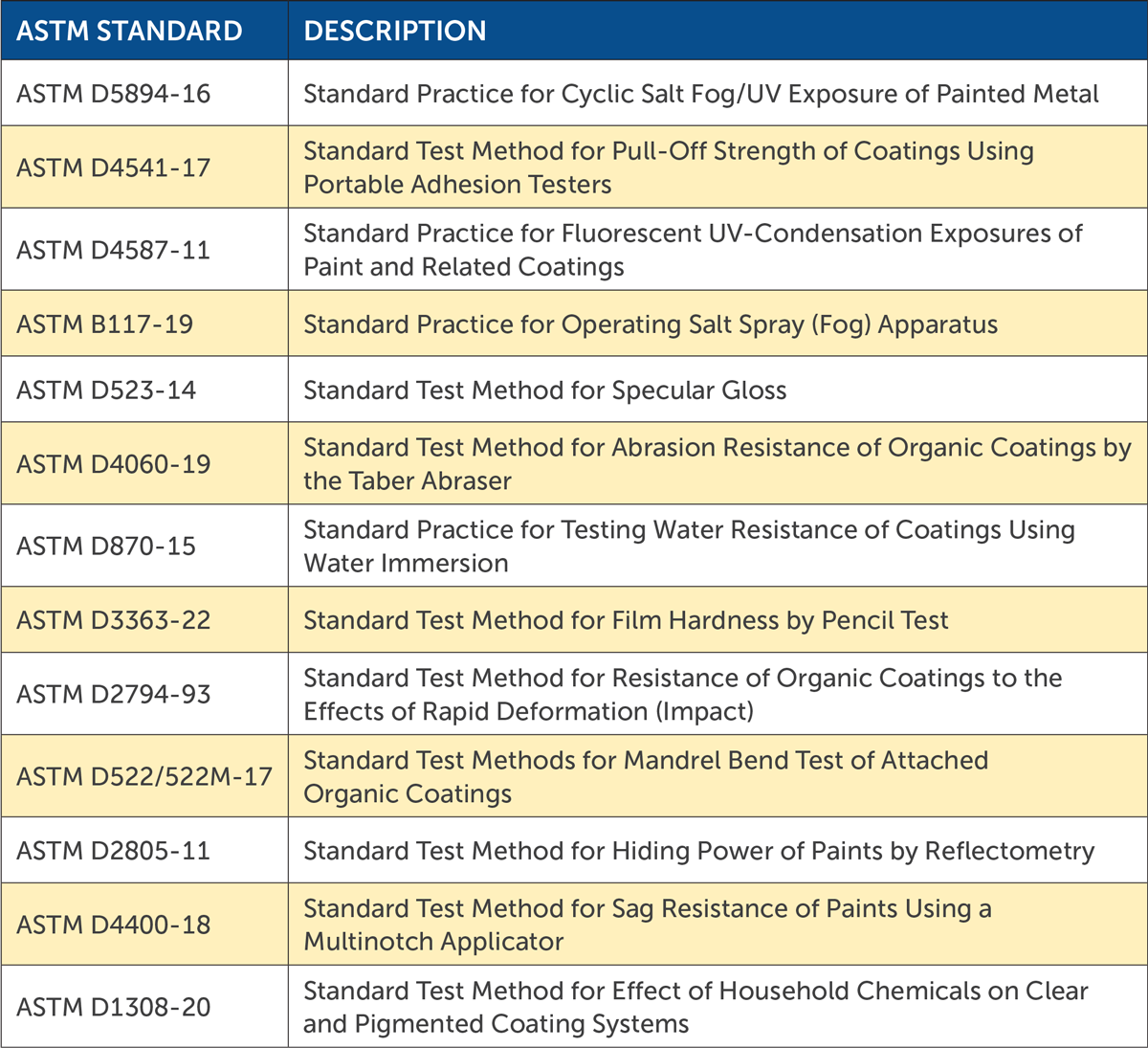
While the primary focus of exterior coatings has traditionally been on functionality, there is now a growing emphasis on aesthetics. Maintaining a car’s aesthetic appeal over many years of service retains the value of assets. Overall cost-effectiveness can be enhanced as a car remains on the tracks without requiring recoating.
Gloss retention—a coating’s ability to maintain its gloss and reflect direct light—serves as a crucial measure of coating durability. As a coating degrades, its surface becomes rough, leading to a reduction in gloss. Rapid loss of gloss in the topcoat is indicative of accelerated deterioration. Without adequate corrosion protection, rust can develop, and components may deteriorate. In the long run, expenses related to rust removal, part replacement and preventable repairs can surpass the upfront cost of applying a protective coating.
Epoxies prioritize chemical resistance over gloss retention, which is also important for durability. However, some epoxies now boast superior weathering properties by chalking black and maintaining visual appeal for many years.
Acrylic coatings offer generally better color and gloss retention compared to epoxies. Still, acrylics can have limited chemical resistance and may not be as durable in demanding conditions.
Water-based acrylic coatings are also more flexible than epoxies, making them suitable for railcars with more aggressive loading or unloading, such as when workers hammer on hopper cars to knock dry commodities loose. While this may pose a potential threat to the exterior coating, water-based acrylic coatings are more impact resistant, taking hammering easier than epoxies, which can fracture.
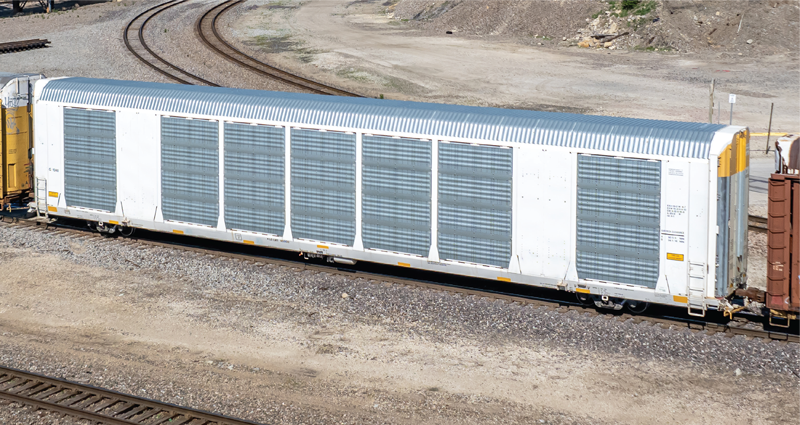
Ensuring that all surfaces of autoracks are fully coated is critical, as any exposed steel surfaces can cause rust bleeding which could damage exterior paint of new automobiles.
Cost Savings
Exterior coatings play a critical role in reducing the total cost of ownership for railcars and promoting profitability. For many car owners, the optimal choice comes down to key questions. For instance, should the paint job be held only until the car’s initial inspection cycle, or should it provide sufficient corrosion protection to last until the subsequent inspection? Various other factors also influence the final coating selection, with water-based acrylics often being the lowest-cost option, but not always.
For specifiers, factors like exterior coating service life, impact and abrasion resistance, edge retention, cleaning compatibility and versatility weigh heavily in decisions to minimize costs. They often focus on the durability of a coating—especially on welded edges, sharp seams and other areas that are crucial for long-term performance and corrosion protection.
For shop applicators, the choice of exterior coating can play a significant role in maximizing facility throughput, as well as reducing labor and equipment costs. For example, with water-based acrylic coatings, shops do not require the sophisticated application equipment for applying high-solids epoxies, which call for plural-component sprayers, which require significant capital investments, maintenance costs, and operator training.
Cost savings can also come from reduced material waste, as newer higher volume solids and improved formulas allow the applicator to achieve better control over film builds when spraying water-based acrylics. In addition, such acrylics feature lower VOC emissions, which leads to decreased shop permitting costs.
Car owners weigh the importance of initial paint and labor costs against the long-term value offered by each coating system, enabling informed decisions based on their bottom-line priorities. Here, water-based acrylic exterior rail coatings can offer multiple advantages in initial cost savings. However, they are not the coatings choice for every circumstance due to durability considerations related to the railcar’s planned service environment – and the type of cargoes that will be transported.
For example, in severe industrial environments, acrylic coatings typically last about eight years, while epoxies often see a service life of up to a dozen years. Considering a railcar’s useful life of approximately 50 years, lessors can expect to repaint their railcars four to five times in these conditions, irrespective of the coating type.
In painting rail cars, customers face an array of considerations to ensure both cost-effectiveness and longevity of the coating. First, understanding the total surface area of the rail car is crucial for accurate cost estimation and material planning. Equally important is the evaluation of labor costs associated with preparatory tasks such as abrasive blasting, masking, painting and stenciling, which typically range between $4,500 and $5,000 per rail car, regardless of the chosen coating system.
Customers must carefully conduct a thorough cost analysis for the expected service life of a coating—considering factors such as durability, maintenance requirements, and environmental conditions. While acrylic coatings may offer lower upfront costs, high-solids and 100% solids epoxies often prove more financially viable in the long run due to their extended durability and lower average yearly maintenance expenses.
Customers should also consider regulatory compliance and environmental impact, ensuring that chosen coatings meet industry standards for safety and performance while minimizing emissions of VOCs. Maintenance requirements—including inspections, cleaning and touch-ups—must also be factored in to ensure the longevity of the paint job and minimize future expenses. Efficiency in shop throughput is another important factor, as higher throughput capabilities can lead to lower overall costs per rail car painted.
Ultimately, by carefully considering these factors, customers can make informed decisions when selecting the appropriate coating system, balancing upfront costs with long-term durability and maintenance expenses for optimal results.
Emphasizing Sustainability
Environmental compliance and adherence to health and safety standards are also part of any deliberation about exterior coatings.
The composition differences between water-based acrylics and solvent-based epoxies are a good starting point for comparison. As shown in Figure 1, solvent-based formulations contain about 30% more solvent and 5% more additives than water-based formulations. These differences naturally contribute to higher VOC emissions when using solvent-based chemistries.
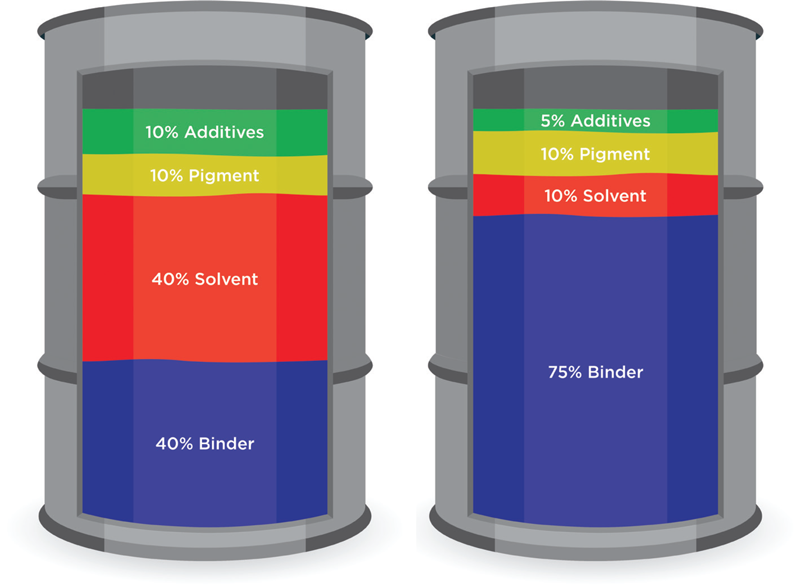
Fig. 1: The composition of solvent-based paints, (left) differs significantly from water-based acrylic formulations (right). Illustration: Courtesy of The Sherwin-Williams Company
Water-based coatings are generally one-component chemistries with lower levels of VOCs compared to traditional solvent-based coatings—contributing to improved air quality, less odor, reduced environmental impact and lower PPE costs.
Typically, waterborne coatings are seen as 20-year systems, which can lead to fewer refurbishments over the course of a railcar’s life. High-solids coatings are designed for long-term durability to enable longer service lives between recoating.
Over time, epoxy exteriors can fade and chalk, due to UV light. Solvent must also be kept around, which can also create hazardous waste. With an acrylic, you would not need those additional expenses or burdens for the shop. Being solvent-free further decreases costs related to thinning and cleaning solvents, while also significantly reducing hazardous waste disposal expenses.
Overall, acrylics are a more environmentally attractive option for those concerned about reporting hazardous air pollutants (HAPs). This is especially important for the health and safety of workers during the coating application process. Water-based coatings often meet or exceed strict regulatory requirements related to air quality and emissions in many regions, helping companies stay compliant.
The milder odor of water-based coatings can also enhance working conditions for applicators. Cleanup can also be performed without the need for harsh solvents, simplifying equipment and tool maintenance and contributing to a safer and more sustainable working environment.
Enhancing Efficiency
An emphasis on swift and efficient application methods in railcar coating underscores the industry’s priority of achieving rapid returns to service.
Acrylic coatings present a notable advantage, requiring less upfront training of applicators and less capital-intensive equipment – since applicators do not need to mix multiple components as they do with epoxy coatings. Advancements allow stenciling in as little as 90 minutes. Many acrylics are also formulated to reduce pot-life concerns and mix-ratio mistakes. However, they have lower solids by volume, necessitating more material to achieve the specified dry film thickness.
Acrylic coatings have faster dry to handle and dry to stencil times, reducing valuable time on the paint line. Touch-up and rework are significantly easier due to the unlimited recoat window that acrylics offer. This lowers total applied costs through increased efficiencies.
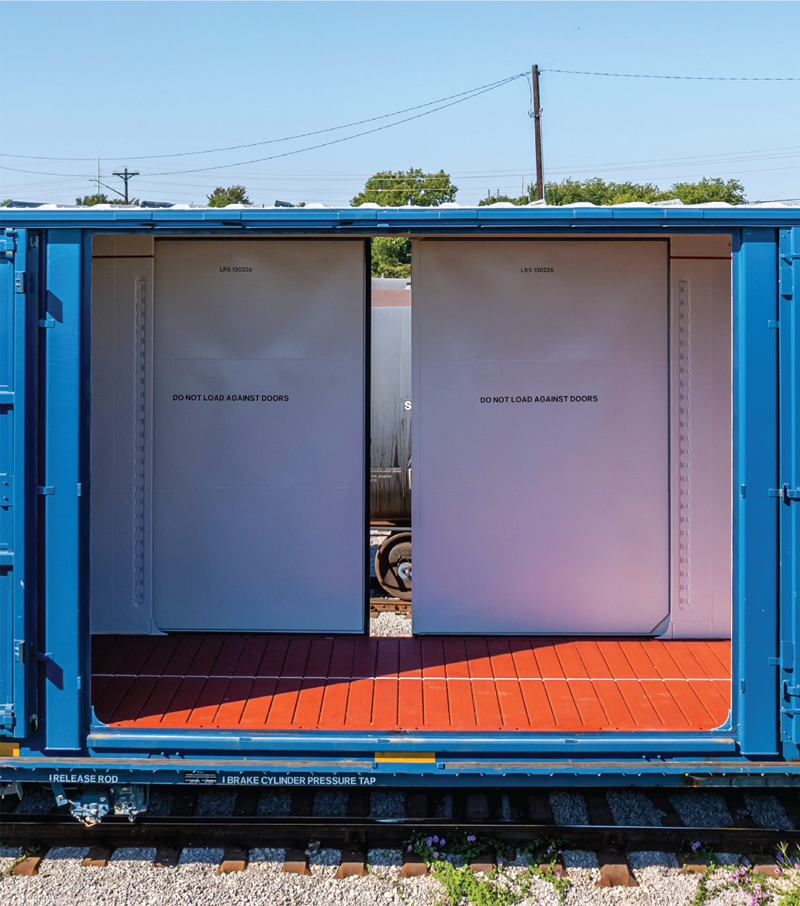
Boxcars receive exterior and interior coatings and carry cargos including paper, automobile parts, cases of beverages, appliances and certain types of food.
Acrylic Availability
Given their chemistry, it’s important to note that water-based acrylics can be susceptible to freezing, complicating shipments based on seasonal conditions, such as low temperatures and high humidity. Therefore, due to seasonal sensitivities, supply chain optimization is essential. This also tends to provide the lowest cost-to-market expenses.
Supply chain resilience—with proximity to customers, just-in-time delivery and reduced indirect costs—helps address this issue. The short shelf life of water-based products can be addressed by locating manufacturing facilities in close proximity to customers, reducing transportation costs.
In the past, water-based products faced challenges due to the high production costs of resin systems. Now, there is more control over manufacturing and the entire process, from resin creation to manufacturing, distribution and expertise in water-based coatings. This control allows for better quality assurance and consistency in the products.
Conclusion
When deciding between acrylic and epoxy coatings, decision-makers must weigh the advantages and disadvantages of each. Acrylics offer a lower initial application cost, less expensive equipment, improved aesthetics and a reduced environmental impact. On the other hand, epoxies tend to provide a lower long-term value by extending the expected service life by a few extra years. Additional factors come into play when considering a water-based acrylic or epoxy option or a solvent-based one.
Consulting with coating specialists and manufacturers can offer tailored insights for the specific requirements of railcar operations and provide options that align with their priorities and profitability goals. That said, water-based coatings are clearly part of a complete portfolio.
ABOUT THE AUTHORS
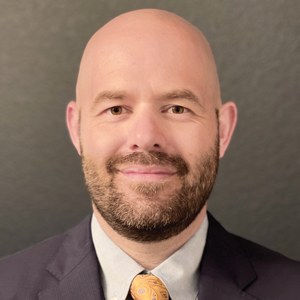
Taylor Lewis, Sales Manager – Freight Rail
Sherwin-Williams Protective & Marine
Taylor Lewis is the Sales Manager – Freight Rail for Sherwin-Williams Protective & Marine. He is an AMPP Senior Certified Coatings Inspector and has nearly 20 years of experience in the coatings industry, including multiple roles in sales and marketing spanning from Alaska to the Gulf of Mexico.
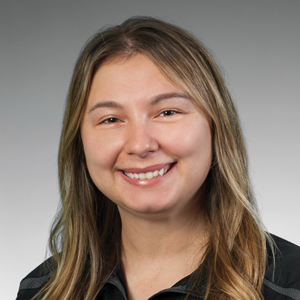
Ana-Maria Hrnjak, R&D Chemist
Sherwin-Williams
Ana-Maria Hrnjak has been an R&D Chemist with Sherwin-Williams for three years, serving on both the Strategic Initiatives and Transportation/Rail teams. Hrnjak became a member of AMPP as well as SC-17 Land Transportation and a certified Level 1 CIP in 2024. She graduated from The University of Akron in 2021 with a bachelor’s degree in chemical engineering with a minor in chemistry and a specialization in polymer engineering. While attending the university, she was an active member of The American Institute of Chemical Engineers.
Tagged categories: Acrylic; Exterior painting; Features; Rail; Railcars; Water-borne



